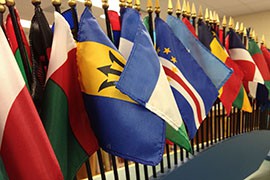Cronkite News has moved to a new home at cronkitenews.azpbs.org. Use this site to search archives from 2011 to May 2015. You can search the new site for current stories.
Foreign students in U.S. in record numbers; Arizona a leading destination
WASHINGTON – The number of foreign students in the U.S. grew 8 percent this year to a record 886,052, and Arizona colleges more than kept pace with a 16 percent increase in the same period, a new report says.
The 2014 Open Doors Report on International Educational Exchange said Arizona ranked 18th among states, with 15,442 international students in the 2013-2014 academic year, an increase of more than 2,000 from the year before.
And Arizona State University had more than half of the state’s total foreign enrollment, with 8,683 students, ranking it eighth-highest among schools in the country.
The U.S. increase was attributed to supply and demand – countries like China and India have many more degree-seeking students than schools to accommodate them – as well as aggressive outreach by some U.S. schools.
“There is so much demand, so students will be looking to other countries to get that overseas education,” said Rajika Bhandari, deputy vice president for research and evaluation at the Institute of International Education.
That institute prepares the annual report in conjunction with the U.S. State Department’s Bureau of Educational and Cultural Affairs.
Even though it gained students, Arizona’s rank at 18 was unchanged from the 2012-2013 school year, the report said.
At ASU, the number of international students has nearly doubled since 2010 as the university strives to meet a goal of 10,000 foreign students by fall 2017, said Kent Hopkins, the vice provost of enrollment management at ASU.
The increase benefits domestic as well as foreign students, Hopkins said.
“We think that university students deserve a university experience that is reflective of the state, the nation and the world,” he said.
The university’s international admissions staffers travel to different countries where they attend high schools and college fairs looking for students who want to study abroad.
“We try to create relationships with students who are interested and help them make good decisions about whether ASU is that right fit for their undergraduate or graduate degree,” Hopkins said.
Ensuring that American colleges and universities are a “right fit,” is what foreign students value, Bhandari said. She said one of the things the U.S. has to offer students overseas is the wide variety of its schools.
“Students have a whole range of institutions they can choose from,” Bhandari said. “It could be a large doctorate research institution like Arizona State or they could be attending a community college.”
In 2013-2014, the countries that sent the most students to the U.S. were China, India and South Korea. Arizona closely mirrored those countries of origin, with China, India and Saudi Arabia sending the most students to the state.
Hopkins said ASU has students coming from a total of 130 countries.
Bhandari said Arizona, as well as the U.S., continues to see an influx of students from countries like China and India. Those two highly populated countries have the largest number of college-aged people in the world.
“Both of the countries do not have enough capacity to educate all of those students,” Bhandari said.
Hopkins said he hopes to see ASU even higher in the rankings when next year’s report is released. But at the end of the day, Hopkins said “a ranking is just a ranking.”
“I think the most important thing is how our students are appreciating the diversification of our student body,” he said.







